

Journal of Medical Sciences and Health
DOI: 10.46347/jmsh.2019.v05i02.003
Year: 2019, Volume: 5, Issue: 2, Pages: 14-18
Original Article
Ilkay Cinar
Department of Pathology, Giresun University Prof. Dr. A. İlhan Özdemir Research and Training Hospital, Teyyaredüzü Mah, Atatürk Bulvarı No: 323 Giresun, Türkiye
Address for correspondence:
Ilkay Cinar, Department of Pathology, Giresun University Prof. Dr. A. İlhan Özdemir Research and Training Hospital, Teyyaredüzü Mah, Atatürk Bulvarı No: 323 Giresun, Türkiye. Phone: 905327981696. E-mail: [email protected]
Aim: The aim of this study is to evaluate the reliability of information about pathology available to people at Turkish websites.
Materials and Methods:The terms “pathology,” “what is pathology,” and “importance of pathology” were scanned into the most commonly used search engine in Turkey of “Google” in Turkish at 2018. The terms used in the research were considered to be terms used by patients and the public. The first 30 results for each search were used. The same websites reached as a result of the search were eliminated. Each website was classified according to the author as health-related organizations, news, personal, doctors, and undetermined. The websites were assessed according to 15-question scale that was prepared to assess information related to definition, functions, and importance of pathology.
Results: The search reached 90 websites. Of these, nine were the same website. As a result, the evaluation included 81 websites. The mean points for the websites were 1.432 (min: 0, max: 13, and standard deviation: 4.28). When the information is distributed according to topic headings, proportionally, the most sufficient information appeared to be about “what is pathology” at 32.1%. The most insufficient information was given about “how does a pathology laboratory work (2.5%),” “place of pathology in genetic studies (2.5%),” and “importance of preventive medicine (2.5%).”
Conclusions: According to our study, the information on “what is pathology” and “important of pathology” on the internet is not sufficient. Pathologists should be aware of this deficiency, and people should be properly informed about the importance of pathology.
KEY WORDS:Pathology, internet, website, analysis, quality.
The internet is currently a source of information that is gaining more importance. In Turkey, the internet access in the first 3 months of 2010 was 36%, while in 2017, this was 66.8%.[1] Along with this rapid increase in the internet access, there are debates about information pollution, and the accuracy of the content of information obtained from this source. At present, debates and studies about this topic have been performed, with the first study product about the accreditation of websites the DISCERN instrument.[2] The DISCERN® instrument can be used by producers, health professionals, and patients to assess written information about treatment choices and is the first standardized quality index for consumer health information.[2]
In the literature, there are studies related to the content of website information about different fields related to health, but there is no study about websites providing information about pathology promotion. The aim of this study is to assess the sufficiency and reliability of Turkish language websites presenting information about pathology.
The terms “pathology,” “what is pathology,” and “importance of pathology” were scanned into the most commonly used search engine in Turkey of “Google” in Turkish at 2018. The terms used were not at the professional level of internet and medical knowledge but were considered to be terms chosen by the public and patients. For each term, the first 30 websites in the search list were identified. A study of Google® traffic found the first 30 results of searches collected 97.4% of all traffic.[3] The first 30 websites determined by the Google search engine were investigated in detail. The same sites were eliminated, and websites were grouped according to the author:
In the first section of the study, websites were assessed using a method modified from Green et al.[4] In this section, 15 questions were prepared to assess information related to definition, functions, and importance of pathology [Table 1]. The website contents were checked to see whether these questions were answered; for each question answered, “1 point” was given, with points out of “15” given. According to points obtained, “1–5 points” were insufficient, “5–10 points” were moderate, and “11– 15 points” were assessed as sufficient.
The second section of the study gave points according to a scale from 1 to 5 (1: No, 2–3: Partially, and 5: Yes) for answers given to 15 questions [Table 2] modified from the “DISCERN instrument.”[2] According to the mean total points obtained, websites were assessed as having low quality (serious or extensive shortcomings) with “1–2 points,” moderate quality (potentially important but not serious shortcomings) of “3 points,” and high quality (minimal shortcomings) with “4–5 points.”
All websites were independently given points by two observers. Cohen’s kappa was used to determine interobserver reliability. All statistical analyses used the Statistical Package for the Social Sciences (SPSS) version 22.0. Statistically significant differences between the groups were analyzed with variance analysis and defined as values lower than 0.05.
As a result of searches for the terms “pathology,” “what is pathology,” and “importance of pathology” with the Google search engine in Turkish, 90 websites in the first 3 pages were investigated. As a result of the search, 90 websites were accessed. After searching for different terms, the same websites were eliminated and 81 websites (90%) remained. According to author classification, the undetermined author group was in the first place (56.8%), followed by health service websites (34.6%), news (4.9%), and doctor authors (3.7%).
Assessments made within the scope of the first section found that only 26 websites (32.1%) answered the question of what is pathology. Pathology in genetic studies and importance of preventive medicine were only mentioned on 2 websites (2.5%) [Table 3]. The mean points for the websites were found to be 1.432 (min: 0, max: 13, and standard deviation: 4.28).
When the information found is distributed according to topic headings, proportionally, the most sufficient information was found for the term “pathology,” with most insufficient information found when researching the term “importance of pathology.”
In the second section, points according to the DISCERN instrument found only 4 websites (4.9%) provided information about the function of pathology. There were 3 websites explaining the benefits of pathology (3.7%). There was no website which explained the risks of treatment without pathologic diagnosis, what will happen if treatment is not given, the effect of treatment chosen according to pathologic diagnosis on quality of life and that there may be more than one treatment choice. Only three of all the websites (3.7%) were about targets, and all of these provided the expected information. While sources of information were clear on 11 websites (13.4%), there was no source of evidence for information mentioned in the remaining 70 (86.6%) websites. Of the websites, 68 (83.9%) contained a clear date for all accepted references. Informationon only 12 websites (14.8%) was fully balanced and impartial. There was no source of additional information in 78 websites (96.3%) [Table 4].
Pathology is a branch of medical science that involves the study and diagnosis of disease through the examination of surgically removed organs, tissues, bodily fluids, and in some cases the whole body (autopsy). However, it is not well known area of medicine by people. As patients generally do not meet pathology experts face to face, they do not know that these doctors who provide diagnoses and are not aware of the contribution of results from pathology laboratories to diagnosis and treatment. According to 2014 data in the Health Education and Health Labor Status Report, in Turkey, a total of 1311 pathology experts work with 797 in hospitals linked to the Ministry of Health, 361 in university hospitals, and 153 in private practice.[5] A survey we administered in 2017 found a pathologist working in a public institution provided diagnoses to between 4000 and 7500 patients annually.[6] The pathology science branch is not just insufficiently known by people outside of medicine but also by clinicians from other branches. This may cause occasional problems with understanding and evaluating written reports and about expectations from pathology by clinical doctors. Better knowledge of pathology will strengthen communication between clinicians and will definitely increase quality in terms of ensuring the patient gains maximum benefit from patient management. The pathology branch has begun to promote itself through social media tools in recent times. The social media group created by the Federation of Turkish pathology societies last year performs active studies on this topic.
The aim of this study was to research the quantity and quality of information that can be obtained on the internet by people wishing to learn about pathology. There are a variety of methods used to assess the quality of information related to health in the literature, and this study used a method modified from Green et al. In addition, the DISCERN instrument created to measure quality about information related to treatment was modified and used.
In 2014, Google® comprised 67.5% of global searches, and as it was the first place in Turkey with 94.9% of searches, this study used the Google® search engine.[7]
Rapid development of the internet, common popularity of personal computers, and many websites providing health information have made the internet the most important and accessible source of information. In the USA, there are more than 70,000 websites providing health information on the internet, with nearly 63% of users searching for information about health on the internet.[8] The excessive number of websites has led to access to misleading, wrong, and dangerous information from unchecked and unregulated websites. The DISCERN instrument was created to determine standards for choices to assess the quality of written information on the internet and for production of high-quality, evidence-based information providing a reference point for authors. DISCERN® is the first standardized quality index for consumer health information. It is used to assess the written information about treatment choices by producers, health professionals, and patients.[2] The most important advantage of the methods used is that all websites were assessed according to a standardized form, and this made it possible to complete an objective assessment.
Ninety one percent (91.3 %) of websites had a low to moderate quality of information, and 71.5% had no information about pathology. Only 8.6% of websites were found to be an appropriate source of information answering explanatory questions about pathology [Tables 5 and 6].
According to the results obtained in this study, 81–92% of answers on the internet to the question of “what is pathology” were insufficient.
When consider according to authors, the difference between all author groups was not statistically significant. Only one health-related website appeared to have statistically better DISCERN points compared to undetermined websites. Interestingly, the points for websites by clinicians and health experts were very low, which shows that there is seriously deficient information in the content of these websites [Table 7].
To improve the quality of information obtained from the internet about pathology, at the same times, it is necessary that websites providing clear, accurate, and sufficient information appear on the first page during the search. As 91.5% of all search traffic are from the first pages, more effort should be expended to place these websites on the first page of search results. This may be achieved by ensuring more links to key words on the website or that will be searched for by users.
There is some limitation of this study: We assessed only Turkish website. Similar studies should be done other countries in the future, and the importance of the pathology should be explained to people correctly. It can be quite difficult sometimes to change the prejudices caused by incomplete or incorrect information obtained from the internet by patients.
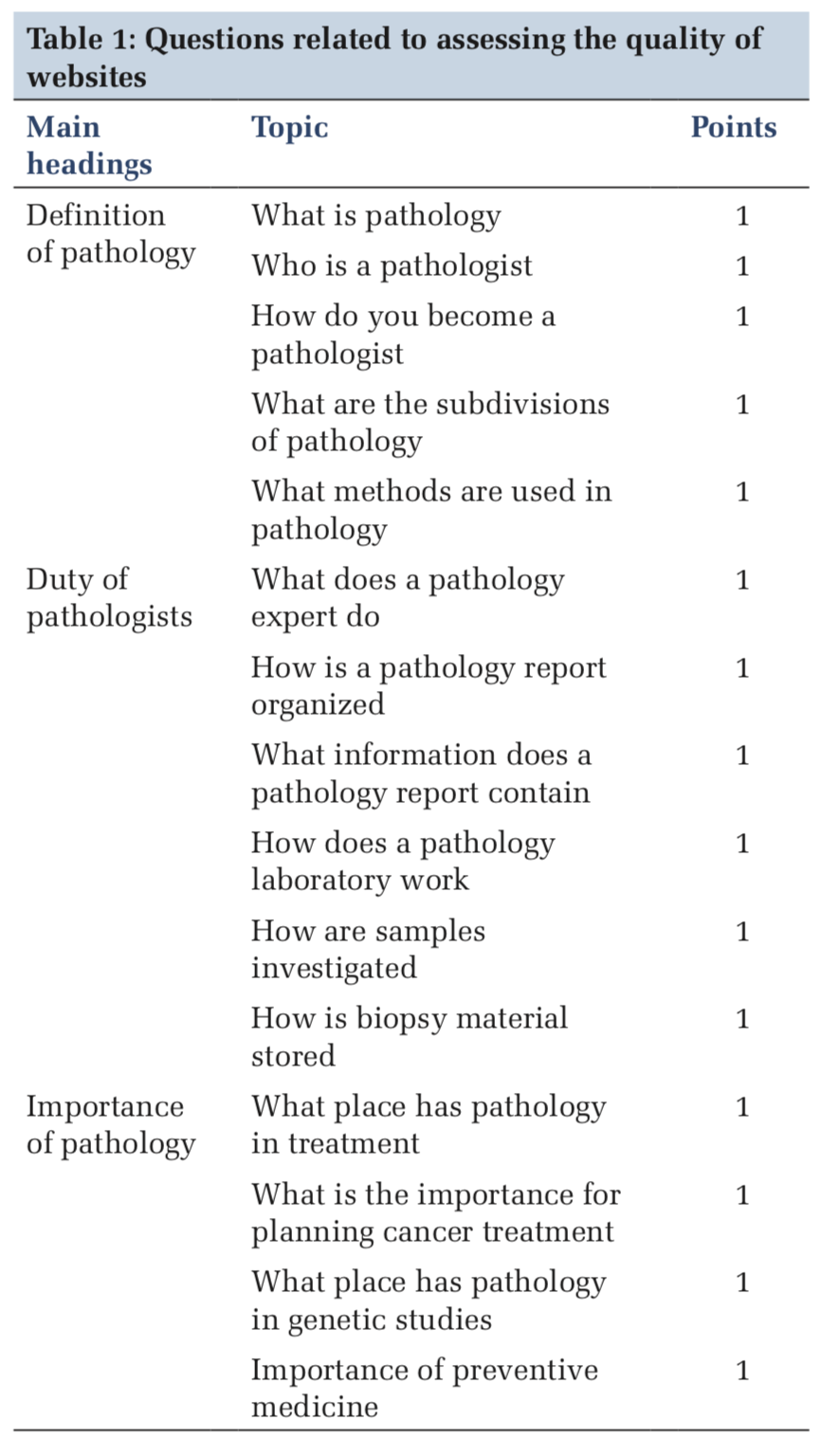
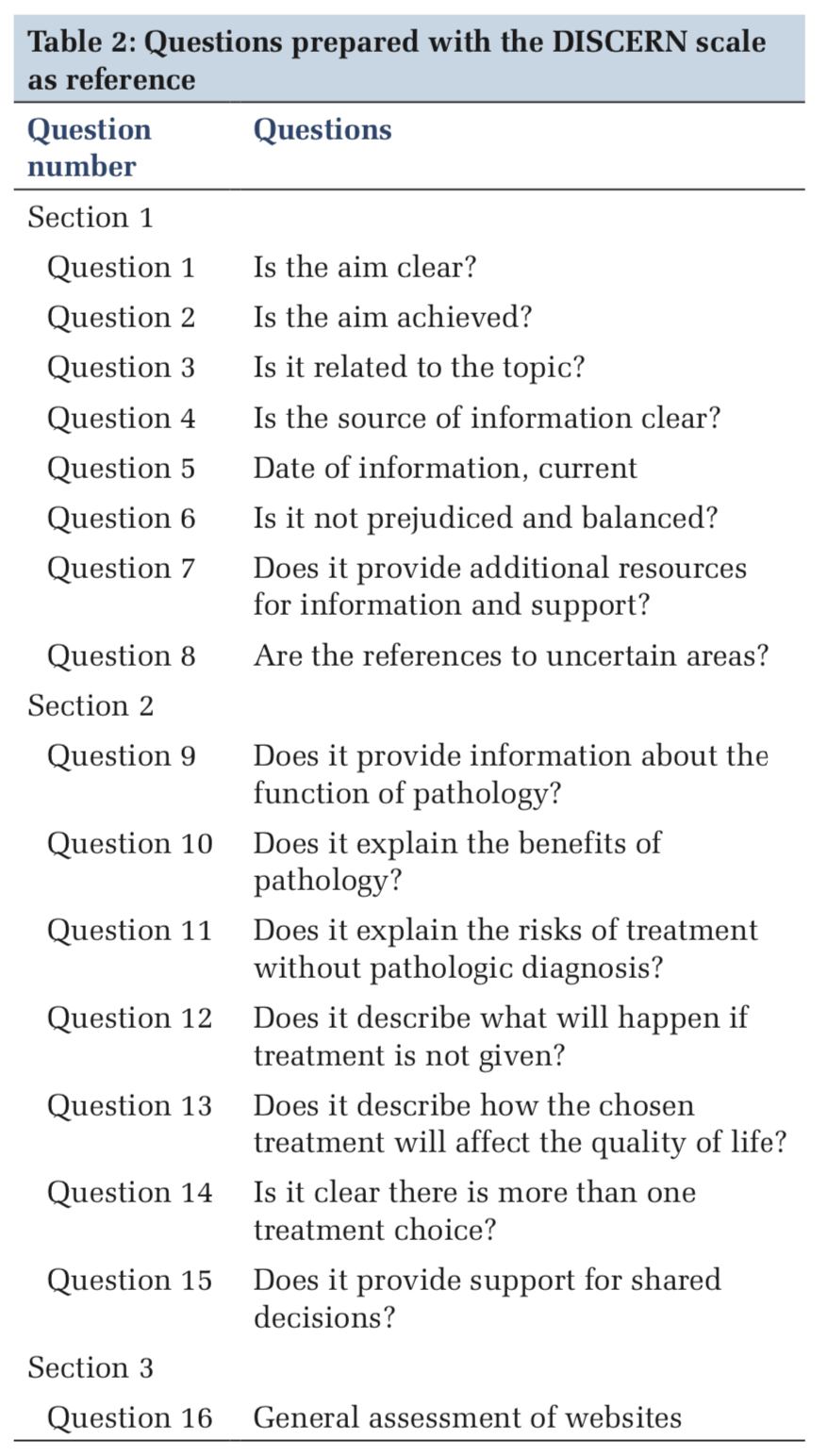
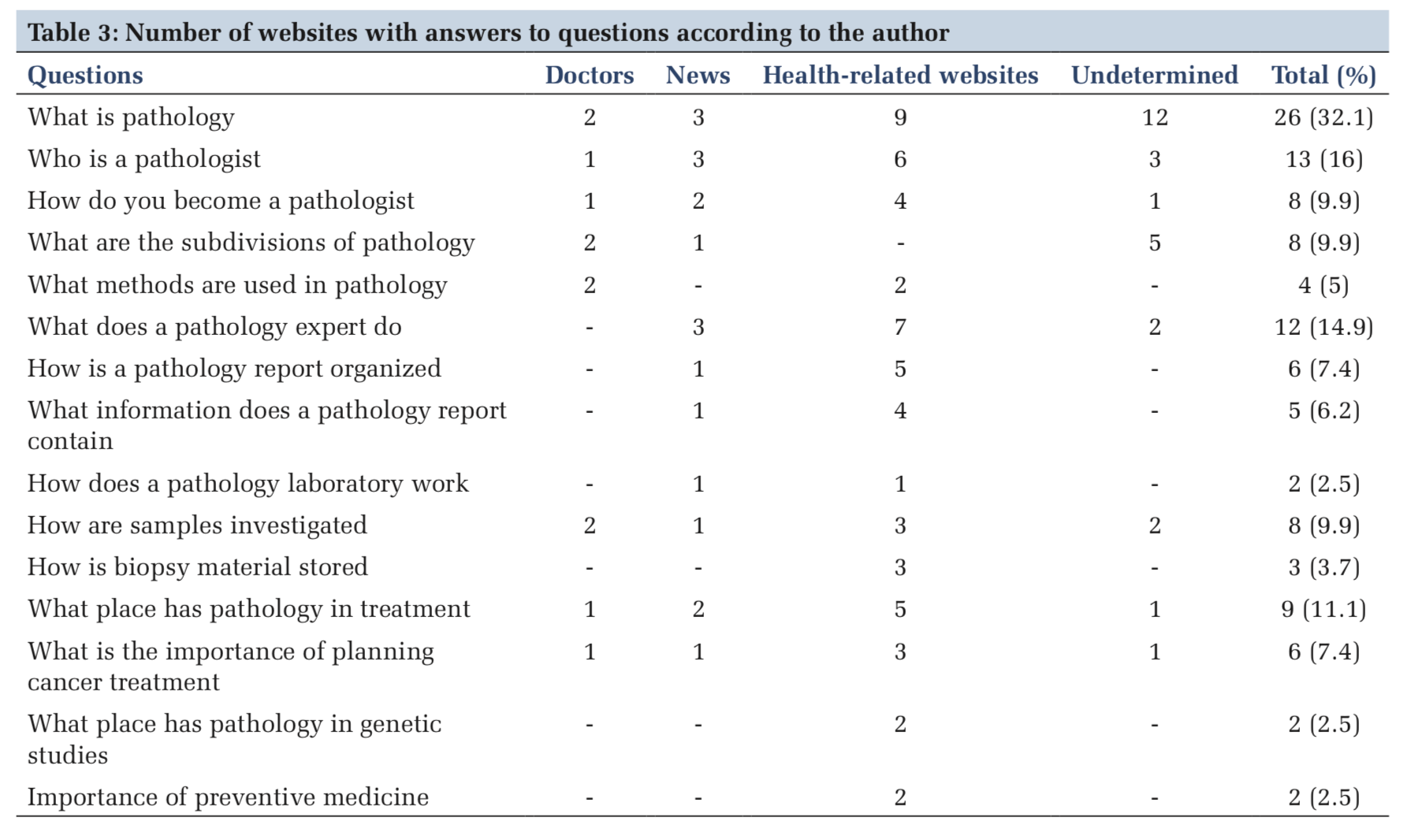
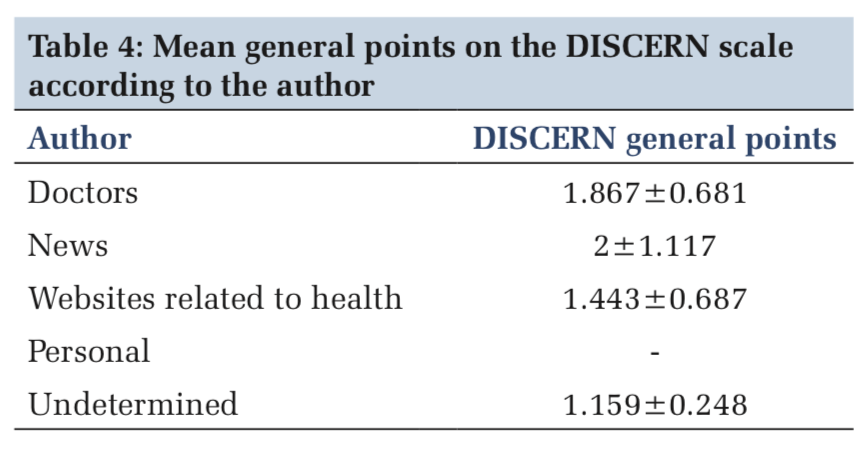


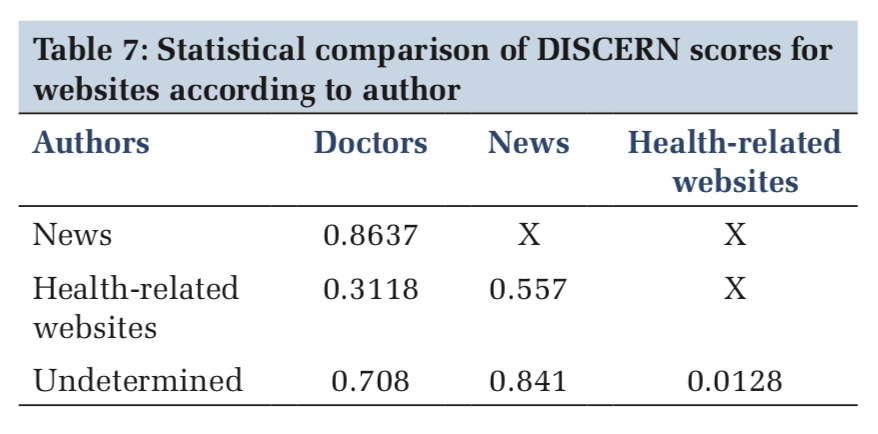
The pathology promotion on Turkish language websites contains very insufficient information. This is a universal problem. People should know what is pathology and important of pathology. Pathologists should tell what they do for people. It is possible to use the interactive and informative advantages provided by websites for the accurate promotion of pathology. Efforts should be made to provide well-written and understandable information explaining what pathology is and its functions and importance. The reliability of health-related information on the internet should be considered as a public health issue affecting large audiences. The studies should be carried out for the dissemination of internet instruments (accreditation systems), which are examples in different languages, aiming to increase information reliability for websites.
Subscribe now for latest articles and news.